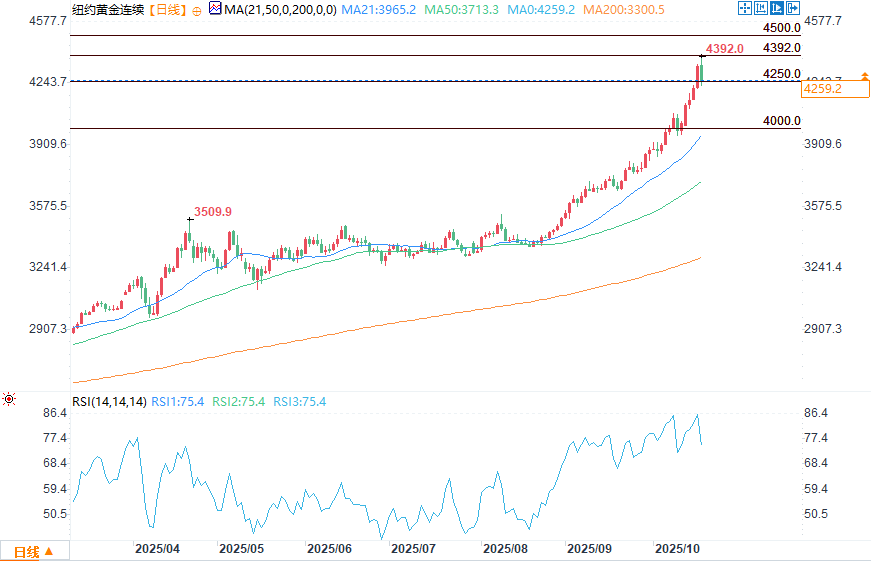Amid market turmoil, gold prices soared to a historic peak before falling back
2025-10-17 23:25:50

Global and US stock market trends
Global stock markets fell across the board overnight, and U.S. stock indices are expected to open sharply lower when trading begins in New York.
Banking and credit concerns hit global markets
Concerns about banking and credit problems are roiling global stock and financial markets. As the trading week draws to a close, market anxiety over soured loans at two regional U.S. banks is particularly concerning, raising questions about the quality of credit in the U.S. economy and further highlighting the fragility of the $28 trillion bull market in U.S. stocks.
U.S. bank stocks continued their decline in overnight trading, following a sharp sell-off in regional bank stocks on Thursday that spilled over into Asian and European trading hours. Investors are concerned that risks remain unidentified, but some analysts believe the sell-off will be short-lived and that regional banks still hold ample reserves to cover potential losses.
However, Zions Bancorp and Western Alliance Bancorp have disclosed loan fraud losses, with Zions' California Bank & Trust providing $60 million in loans to borrowers. Bloomberg News reports that the suspects involved are investment funds associated with Andrew Stupin and Gerald Marcil, who have "strongly denied" the allegations through their lawyers.
The revelation triggered a sharp reaction from stock market investors, with the market value of 74 major U.S. banks wiping out more than $100 billion this week. It also follows other recent lending crises, including the bankruptcy filing last month of subprime auto lender Tricolor Holdings and the subsequent collapse of auto parts supplier First Brands Group, which owed more than $10 billion to several prominent Wall Street firms.
JPMorgan Chase CEO Jamie Dimon warned investors on Tuesday, before the latest revelations, that more credit problems could surface. Following JPMorgan's third-quarter earnings report, which included a $170 million loss from the Sanse Holdings incident, Dimon said, "When you see one cockroach, there's probably more. Everyone should be wary of this." It was amidst market panic that safe-haven demand pushed gold prices to new highs overnight.
Dollar suffers worst week in two months
The dollar index fell for the fourth consecutive trading day today, and is expected to record its biggest weekly drop in more than two months, influenced by dovish signals released by Federal Reserve officials and new concerns about U.S. regional banks.
Overnight, the yield on the two-year U.S. Treasury bond fell to a three-year low. Today, the yield on the benchmark 10-year Treasury bond fell below 4.0%. According to Bloomberg, traders have increased their bets on a Federal Reserve rate cut, now expecting a 53 basis point cut by the end of the year, compared to a 46 basis point expectation on Wednesday.
Federal Reserve Governor Christopher Waller said Thursday that Fed officials could lower U.S. interest rates by 25 basis points at a time to support a weak U.S. labor market, while Governor Stephen Miran reiterated his view that a 50 basis point rate cut would be appropriate at the Federal Open Market Committee (FOMC) meeting later this month.
IMF: US-China trade dispute poses significant risks to global economic growth
The International Monetary Fund (IMF) sees "significant downside risks" to global economic growth due to renewed trade frictions between China and the United States, Krishna Srinivasan, director of the IMF's Asia and Pacific Department, said on Friday.
After months of temporary stabilization in Sino-US relations, tensions have escalated again in recent weeks: the US has expanded technology restrictions on China and proposed tariffs on Chinese ships entering US ports. China has retaliated with similar measures, introducing tighter export controls on rare earths and other key materials.
“If these risks materialize — further tariff increases, supply chain disruptions — global growth could be cut by 0.3 percentage points,” Srinivasan told Bloomberg Television’s Haslinda Amin on Friday.
Key external market dynamics
Key external market data today showed that the US dollar index weakened again; crude oil prices fell slightly, trading around $57.25 per barrel; the benchmark 10-year US Treasury bond yield is currently 3.94%.
December gold futures technical analysis

(Comex Gold Daily Chart Source: Yihuitong)
From a technical perspective, December gold futures bulls have a clear overall near-term technical advantage. Bulls' next upside price objective is pushing futures prices above key resistance at $4,500.00. Bears' next near-term downside price objective is pushing futures prices below key technical support at $4,000.00.
The first resistance level is seen at the all-time high of $4392.00 set overnight, with further resistance at $4400.00; support is at $4250.00.
December Silver Futures Technical Analysis
From a technical perspective, December silver futures bulls have a clear overall near-term technical advantage. Silver bulls' next upside price objective is pushing futures prices above key technical resistance at $55.00. Bears' next downside price objective is pushing futures prices below key support at last week's low of $46.70.
First resistance is seen at the all-time high of $53.765 set overnight, with further resistance at $54.00.
Gold Market Pricing Mechanism Explained
Note: The gold market operates primarily through two pricing mechanisms. The first is the spot market, which quotes prices for immediate purchase and delivery; the second is the futures market, which determines prices for delivery at a future date. Due to year-end position adjustments and market liquidity factors, the most actively traded gold contract on the Chicago Mercantile Exchange (CME) is December gold futures.
- Risk Warning and Disclaimer
- The market involves risk, and trading may not be suitable for all investors. This article is for reference only and does not constitute personal investment advice, nor does it take into account certain users’ specific investment objectives, financial situation, or other needs. Any investment decisions made based on this information are at your own risk.





















